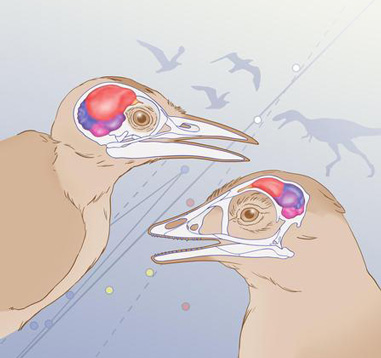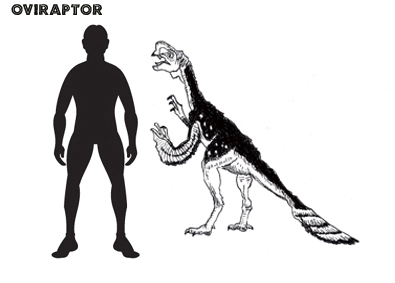New Study Shows Dinosaur Brains Pre-programmed for Flight
Dinosaur “Bird Brains” – Enlarged Brains in the Dinosauria Aided the Evolution of Powered Flight
New research published in the academic journal “Nature” provides evidence that some types of dinosaur developed the brain power required to manage the complex co-ordinated movements that are necessary for powered flight. It seems that, according to this new study, some dinosaurs were “bird- brained”.
Dinosaur Brains
The term “bird-brained” can be used in a derogatory sense, however, the brains of birds can be quite large in proportion to their body size, previous research has shown that parts of the brains of birds are highly developed, even when compared to mammals. After all, it takes great skill and co-ordination to achieve the balance and control required for powered flight. It seems that members of the Dinosauria evolved “bird-brains” long before their descendants actually took to the skies as true birds.
Avian and Non-Avian Dinosaur Brain Study
Picture credit: AMNH/M. Ellison
Intelligent Birds
Some extant birds are remarkably intelligent, the humble pigeon can demonstrate amazing feats of memory as they navigate, parrots and members of the starling family (Sturnidae) such as the famous Mynah bird are wonderful mimics. In 2009, Everything Dinosaur team members reported on a study involving members of the crow family (Corvidae) which demonstrated the problem solving abilities of some birds.
To read more about the clever crows: Birds show how clever their “bird-brains” are.
Lead author Amy Balanoff, a research associate at the American Museum of Natural History (New York) and a post-doctoral researcher at Stony Brook University, along with her colleagues has shown that a number of non-avian dinosaurs had brains that were at least as big (in proportion to body size), as that of Archaeopteryx lithographica. This suggests that at a few of the members of the Dinosauria possessed the neurological hard-wiring essential for flight.
Computer Model Showing the Endocast of Archaeopteryx (A. lithographica)
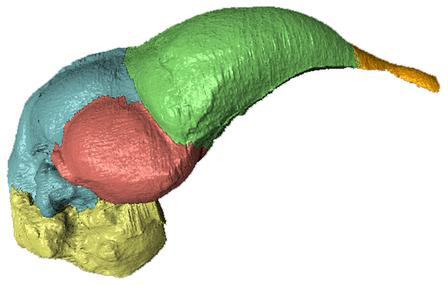
The brain cast of Archaeopteryx lithographica, one of the earliest known birds, partitioned into neuroanatomical regions: brain stem (yellow), cerebellum (blue), optic lobes (red), cerebrum (green), and olfactory bulbs (orange).
Picture credit: AMNH/Dr. Balanoff
Amy commented:
“Archaeopteryx has always been set up as a uniquely transitional species between feathered dinosaurs and modern birds, a half-way point.”
Examining Archaeopteryx
Recent studies, have suggested that the likes of Archaeopteryx may not be the first bird after all, its position as a transitional fossil has also been brought into question. In the light of this new research, it seems that the brain of the Late Jurassic Archaeopteryx may not have been unique.
Amy went onto add:
“By studying the cranial volume of closely related dinosaurs, we have learned that Archaeopteryx might not have been that special.”
Archaeopteryx must be one of the most intensively studied vertebrates in the whole of the fossil record. Back in 2009, a team of scientists based at the Natural History Museum (London) analysed Archaeopteryx fossil material in a bid to understand more about the brain function and sensory abilities of this crow-sized, feathered creature. The research team concluded that Archaeopteryx could hear as well as an extant Emu.
To read an article on this research: Examination of the Senses of Archaeopteryx.
Comparing Birds to Reptiles
When compared to extant reptiles, for their body size, birds generally have larger brains. This “hyperinflation” is most obvious in the forebrain, an area of the brain dedicated to processing data from the optic nerve (eyesight) and co-ordinating body movement. These anatomical and neurological features, once thought as exclusive amongst Aves (birds), may also be present in the Dinosauria.
The Model of a Woodpecker’s Brain with Endocast Partitioned to Show Neuroanatomical Positions
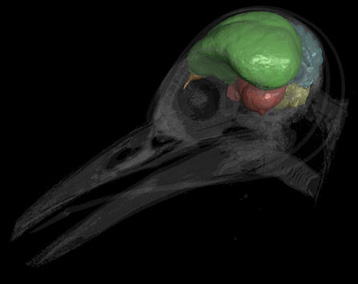
A modern woodpecker (Melanerpes aurifrons) with its brain cast rendered opaque and the skull transparent. The endocast is partitioned into the following neuroanatomical regions: brain stem (yellow), cerebellum (blue), optic lobes (red), cerebrum (green), and olfactory bulbs (orange).
Picture credit: AMNH/Dr. Balanoff
Computerised Tomography
The scientists used high-powered computerised tomography scans (CT scans) to piece together the braincases of more than two dozen specimens, modern birds such as woodpeckers, the ancient Archaeopteryx and closely related non-avian dinosaurs such as tyrannosaurs and oviraptorids. The three-dimensional images that were created allowed the research teams to identify specific portions of the brain such as forebrain as well as permitting a calculation regarding overall cranial capacity. Major regions of the brain such as the olfactory bulbs, cerebrum, cerebellum, brain stem and optic lobes could be identified.
Reflecting on this study, co-author Gabriel Bever (Assistant Professor of Anatomy at the New York Institute of Technology), said:
“The story of brain size is more than its relationship to body size. If we also consider how the different regions of the brain changed relative to each other, we can gain an insight into what factors drove brain evolution as well as what developmental mechanisms facilitated those changes.”
Studying Brain Volume
When compared to the members of the tyrannosaur family, or to oviraptorids, the research team discovered that in terms of brain volume, Archaeopteryx is not in a unique, transitional position between what are termed non-avian dinosaurs and extant birds. Several other non-avian dinosaurs examined, including oviraptorids and troodontids, actually had larger brains relative to body size when compared to A. lithographica.
A spokesperson from Everything Dinosaur, stated:
“Relatively large and well developed brains in certain families within the Dinosauria are not that surprising when you consider some of the niches that these reptiles may have occupied. The dinosaurs included in this study were probably very active, possibly living in packs or family groups with attendant complex behaviours. They were active, agile hunters and as many were very probably feathered, it is also likely they performed complicated movements as part of courtship or other types of visual displays.”
The Endocast of the Oviraptorid Citipati (C. osmolskae)
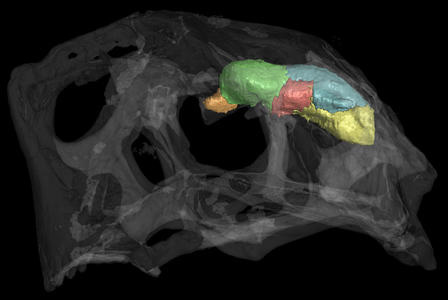
The transparent skull and opaque brain cast of Citipati osmolskae, an oviraptor dinosaur, is shown in this CT scan. The endocast is partitioned into the following neuroanatomical regions: brain stem (yellow), cerebellum (blue), optic lobes (red), cerebrum (green), and olfactory bulbs (orange).
Picture credit: AMNH/Dr. Balanoff
In conclusion, Dr Balanoff stated:
“If Archaeopteryx had a flight-ready brain, which is almost certainly the case given its morphology, then, so did at least some of the non-avian dinosaurs.”
Oviraptorids Included in the Study
Picture credit: Everything Dinosaur
The research team also examined another factor which is vital to powered flight in modern birds, a neurological structure referred to as the wulst, which has an important role in data processing and motor control. In the scans of the Archaeopteryx cranial region, the scientists discovered an indentation that might be homologous to the wulst seen in the brains of extant birds. No evidence of this indentation could be found in the brains of the dinosaurs that were involved in this study, even though proportionately, these dinosaurs had bigger brains than Archaeopteryx.
The evolution and development of the wulst is an area of research which the American based team are keen to explore.
Everything Dinosaur is grateful to the American Museum of Natural History for information used in the compiling of this article.


